Wheat Grinding 101: All About Wheat Grinders {Plus over 60 Reviews of Popular Grinders}
Welcome to the second installment of the Wheat/Wheat Grinding 101 series!
The first installment is here and talks about the types of wheat, where to buy wheat and what to do with it.
Today, I want to delve into a specific part of wheat grinding: The Wheat Grinder. There’s some good stuff here today including, but not limited to, the compiled list of wheat grinder reviews that many of you submitted!
But first, let me address a question I received several times after the first post a few weeks ago.
Why do I grind my own wheat instead of just buying wheat flour at the store?
1) I Stay In Control: I can control the type of wheat I use (many wheat flours at the store are derived from red wheat berries and I prefer a mix of red and white wheat or white wheat on its own), I can control the fineness and/or coarseness of the flour and with my wheat grinder, I can grind it much finer than the wheat flour from the store, I can control when I grind it which means by grinding and using immediately (or freezing), the wheat hasn’t lost any nutritional value (once the wheat berry is ground it is subject to oxidation which causes it to gradually lose nutritional value so freshly ground wheat is more nutritious than wheat flour that’s been on the shelves for a month).
2) It’s Cheaper: because I can buy wheat berries in bulk (see here for sources), I can grind my own wheat flour much more cost-effectively than buying already ground wheat flour.
3) It’s Not Just About Flour: Using wheat berries and a grinder, I can not only grind flour, but I can also make cracked wheat and grind a variety of other grains/seeds (I’ll talk about that in more detail below).
4) It Keeps Me Safe: Despite what natural disaster and emergency may occur (I’m talking even the loss of a job or financial difficulty), I know that I have 100 pounds of wheat ready to grind for a variety of foods that could help sustain our family. We’ve gone through “lean” months/years before and our wheat and other food storage has been a huge blessing and sometimes nothing short of a miracle.
5) It’s Healthy: Because I have a wheat grinder sitting on my kitchen counter and a bunch of wheat berries ready to be ground, I naturally use whole grains in most of my baking, making our bread and throwing it into cookies and other baked goods and breakfast foods willy nilly. Because I can. And eating a whole wheat chocolate chip cookie somehow feels a little healthier. Don’t burst my bubble, please.
Grinding flour and other grains is an investment, there is no doubt about it. Wheat grinders are not cheap; but for me (and I can only speak for myself here), the above factors more than make up for any of the downsides. However, wheat grinders and grinding wheat are not for everyone!
This series isn’t supposed to put pressure on anyone – it’s simply a resource for those who already use/grind wheat or who are looking to start. If you know me well enough you know I’m the last person that wants to make you feel badly for something you aren’t doing. Trust me, I may grind my own wheat, but you definitely don’t want to see the state of my laundry room and/or toilets. We all have our strengths.
Okie doke. Ready to get started on wheat grinders?
First, I’m going to show you the wheat grinder I have. I’m in love with it. I’ve had it for almost 4 years now and I use it at least 4-5 times a week because I grind my wheat fresh for everything I make. I keep this baby on the counter tucked into a little corner and there it stays day in and day out.
My grinder (grain mill if you want to get technical) is a European model that has gained popularity in the United States just in the last few years. It is called a KoMo Fidibus or Wolfgang mill. I have the Classic model. In addition to wheat, it can also grind: oats, rice, triticale, kamut, spelt, buckwheat, barley, rye, millet, teff, quinoa, amaranth, sorghum and dent (field) corn. It will also grind spices, lentils and dry beans (pinto, red, garbanzo, kidney, etc.). Considering I don’t know what many of those foods even are, I use it for wheat 99% of the time, but you better believe I’m ultra-proud it can grind the other foods, too.
Let’s walk through how it operates and then I’ll talk about the pros and cons.
Just like most wheat grinders on the market today, it has a large “hopper” or bowl-type apparatus on top of the grinder. Hello, hopper!
The hopper is loaded up with wheat berries. The hopper on my grain mill fits about 6 cups of wheat berries. This amount will vary depending on the type of wheat grinder you have.
Once filled (and you don’t have to fill it all the way to grind), I turn on the small power button on the side and it starts doing its thing.
I set my large Pyrex bowl underneath and the ground flour spills into the bowl.
I find I can get about 12 cups flour for every 6 cups of wheat berries I grind. Keep in mind, though, that freshly ground flour has more air to it and so if you want a really accurate measurement, let it settle before you measure. I never bother with that; I just pack it slightly more into the cups if it just came out of the grinder.
Again, along with most other wheat grinders, my beloved mill, has a setting that lets me adjust the texture of the flour from fine to coarse. I simply twist the hopper bowl to get finer or coarser flour.
When it’s all said and done, I’m left with beautiful, fluffy flour. Amazing!
The thing with wheat grinders is that each of them differ slightly – in price, capacity, noise, fineness of flour, etc. So the best advice I can give if you are in the market for a wheat grinder is to do your research. I had a Nutrimill for 5 or so years before buying the KoMo mill. The Nutrimill is great and a very heavy-duty mill but the one I had eventually started having some major issues (including but not limited to spewing flour in a 5-foot radius).
As for the KoMo, the main pros are:
-I can keep it on my counter at all times because it takes up very little space which means I can grind wheat on demand (no more pulling out the wheat grinder from storage to grind flour).
-It’s fast and can grind flour as finely as any other mill I’ve used. It also can make fantastic cracked wheat because the coarse settings are easy to adjust.
-It can grind far more than just wheat (see the list at the top of the post).
-It doesn’t heat up the flour like other wheat grinders can which helps retain the most nutrition.
-It doesn’t spew flour anywhere. Occasionally I’ll wipe up a bit of flour dust after a week or so of using (you’ll notice from the pictures above that my baby looks a bit dusty but that’s because it’s been a while since I’ve wiped her down) but it is very clean when grinding.
-Speaking of cleaning, it doesn’t need it. No parts and rings and equipment to take apart and clean which means a very low risk of those pesky weevils taking over. Run a handful of rice through it every month and you are good to go.
The cons are:
-It’s pricey; one of the most expensive mills on the market. I saved my pennies for a year or so before buying but it was worth every single one.
-It’s noisy. Akin to the volume of my vacuum.
-The capacity of the hopper is smaller than other heavy-duty mills. This isn’t a problem for me because I grind wheat on demand but if you like to grind, say, 20 pounds of wheat at a time, you would need to fill the hopper more frequently than mills with a larger capacity.
Because you shouldn’t just take my opinion on what kind of wheat grinder to purchase/use, I asked for input on what kinds of wheat grinders all of you use and what you love/don’t love about them. Over 50 of you responded (bless you, everyone!). The results have been compiled in an easy-access document so you can read what others have to say about the mill they use. I read it like a novel. It’s good stuff, people. Click on the image to access the full document.
Here’s an at-a-glance view of how many of you own what type of grain mill:
And just for fun (seriously, I need to get more hobbies), I did a cost comparison on all of the wheat grinders listed in the above graph. These are using average prices since actual price can vary based on sales and where you buy.
The best way to figure out where to buy a wheat grinder is to check your local retailers (unless you are me and live in the sticks; wheat grinders are not necessarily widely available in my neck of the woods) and also look online. I’ve listed a few places that have sold wheat grinders to my friends/family (I bought mine from a company that no longer sells them):
Pleasant Hill Grain
Emergency Preparedness
Amazon
Now, a word about manual wheat grinders. If you are into preparedness and food storage, it might be worth looking into a manual or electricity-free wheat grinder. These beautiful heavy-duty wheat grinders won’t do a lick of good if the electricity is out. However, you could argue that you won’t be making bread if the electricity is out, either, although, as discussed in this post, there are many other ways you could use wheat berries to provide nutrition for you and/or your family during an emergency (i.e. if you have a propane stove or other heat source you could make cracked wheat, pancakes, etc.). Anyway, just a little bit of food for thought. I do not have an electricity-free wheat grinder, so I can’t recommend a brand, but googling “electricity free wheat grinder” or “hand wheat grinder” will pull up some good resources.
Ok, that’s it! Did you make it through? Let me know if you have any questions. Ah, I just love talking about wheat!

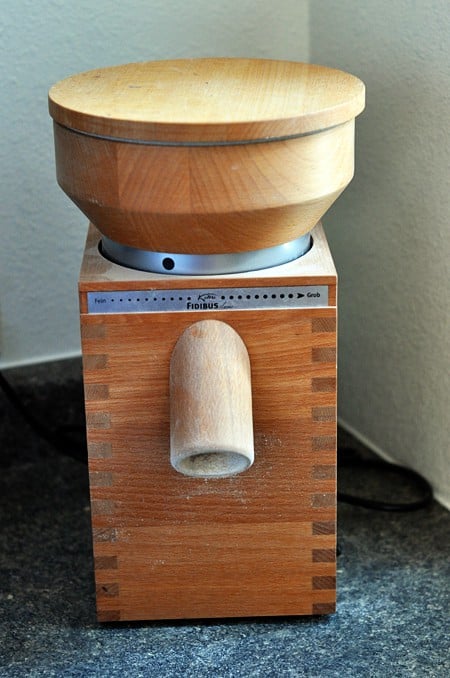
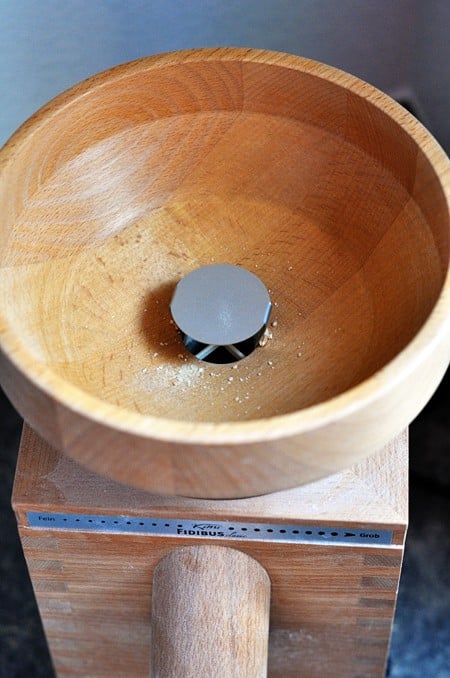
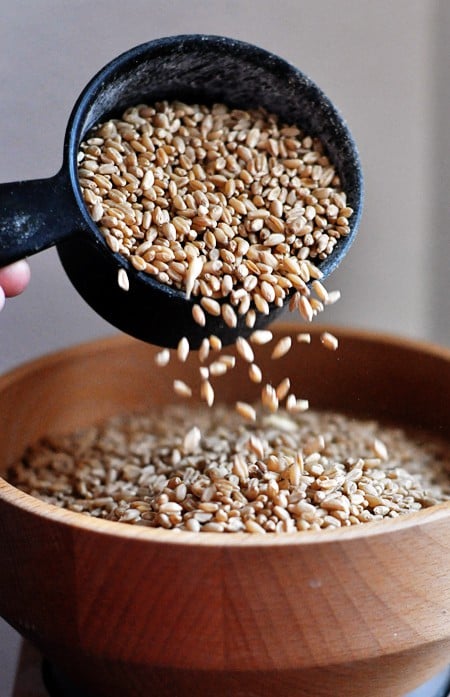
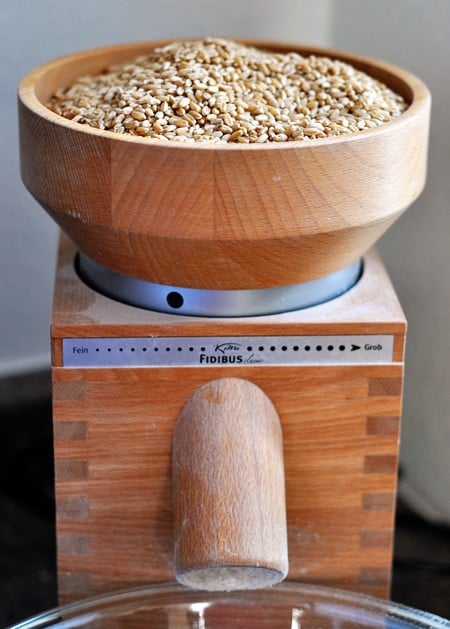
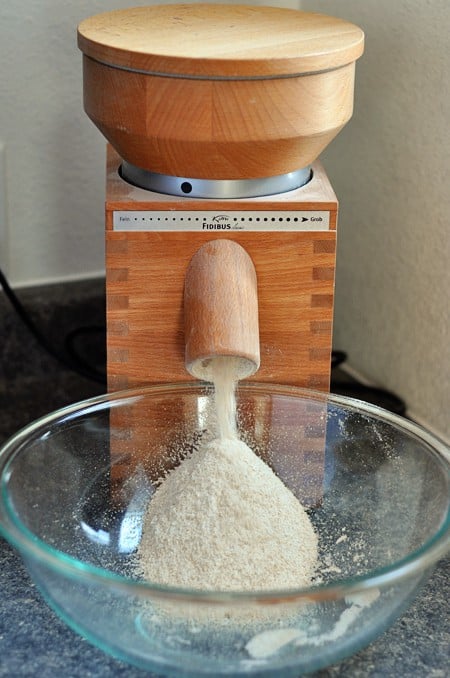
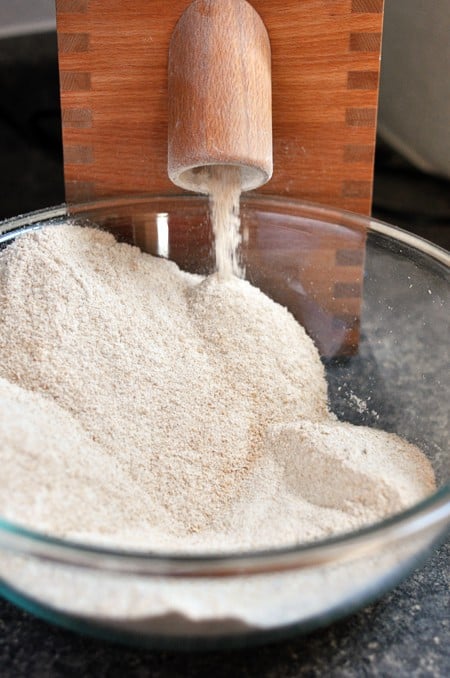
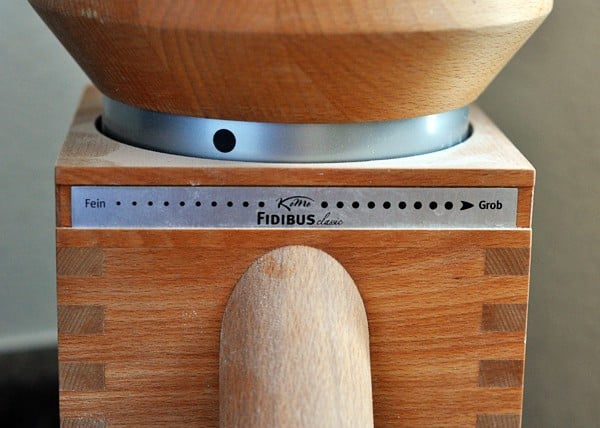
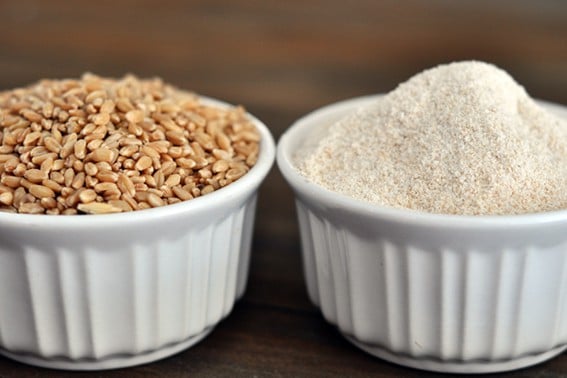
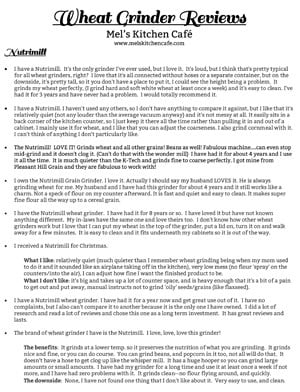
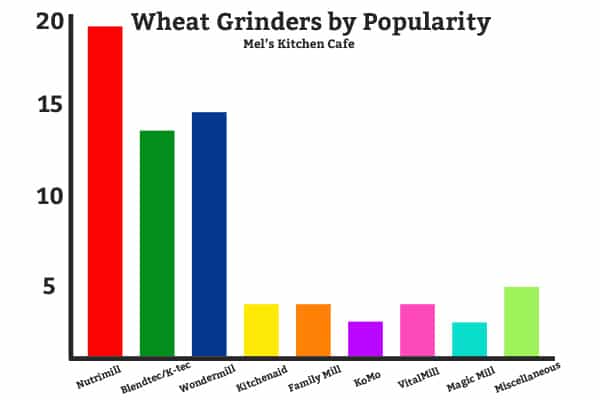
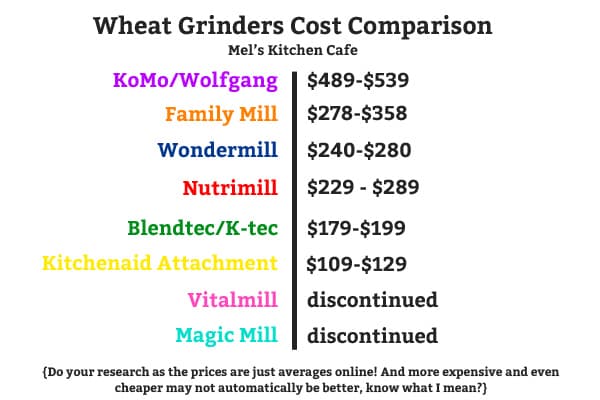
Hi there, I am so so thankful for your blog! It has been incredibly helpful in learning all about milling my own flour. It seems like the mill you have is out of stock everywhere. The Komo Milo (360w)is available though and is more affordable. Obviously you wouldn’t be able to speak to personal use but have you heard anything about this one?
Hi Emily – thanks for the reminder that I should update this post with new links! I haven’t tried that specific mill, but it gets really, really good reviews and I’ve heard from other people it is excellent. The mill I have from that brand is going on almost 20 years, so I think it’s a great company that makes excellent products.
The WonderMill is really, well, wonderful! Does a great job milling. Has a separate container for the flour. Never needs cleaning. Can mill to the finest level you need. Two thumbs up.
Hello. I’m looking into purchasing a mill. This post is from 2013…I’m wondering if you still stand behind your 360 watt KoMo?!
Yes! I’ve used it several times a week for over 10 years and it’s as good as new!
I also have the Komo Fidibus mill and absolutely love it.
Do you think a Magic Mill would be good to purchase? I can find several in my area and wonder if they’re made better than some of the newer models. But I’m worried if it breaks what I would do.
I am new to grinding flour and I have a Nutrimill that looks a lot like your KoMo. My flour does not come out very fine. The bran is always very course and heavy and I think I am doing what they say, turning the wheel until you hear the stones start to rub on each other.
Do I always have to sift out the bran? Or is there a way to get fine flour from every part of the wheat berry?
I tried making tortillas from hard red wheat (that is what I have the most of) and they are hard little disks! I could fry them and use them for tostadas, but that was not my original intent!
Any help would be appreciated!
Hi Sandra, my recommendation would be to try a different variety of wheat. I like using hard white wheat or soft white wheat. It has a lighter texture and flavor than red wheat.
Hi, My Nutramill is NOT grinding Coarse, as it says it does,if i turn it all the way to the Right. We messed with the Feed rate, ths=inking that may help, but same Fine Flour! ;-( Grrrr and ideas? Seems like her dial is nqr…not quite rite
Thanks
This would have been the first time i moved the dial. I have used it for Prairie Gold, Red hard wheat, spelt, and kamut only. and the dial was Mid way, aka Noon…Thanks in advance, Teresa
Thank you for the great input.
Mel,
I have been making breads for about 5 years now (my bible has been Forkish’s “Flour Water Salt Yeast”) and my kids got me the Komo Fidibus Classic this past Christmas. I have enjoyed expanding my bread making hobby into grinding my own wheat (hard red and hard white) & rye (so far).
While I am very happy with the quality of flour I am getting for whole wheat recipes, I’ve yet to find a proper technique for approaching AP consistency/performance (namely for cookies, brioche dough, Japanese-style milk bread, etc..). I was wondering if you have mastered any techniques for this.
I have been grinding according to instructions and then using a series of super fine sieves — #20, #30, #50 — I’m only losing about 9% of the total weight of the berries (91% extraction). My understanding is that AP flour is around 72%… so I am clearly keeping too much of the germ/bran. I am starting to think that one technique might be to do a coarse grind, sieve, then do a fine grind…
I would have thought I’d find someone’s technique on this — found your site and hoping you might have some experience in this.
Thanks for your time,
Dave Mc.
Hi Dave – sounds like a fun process! I have loved grinding my own wheat and other grains…but I can tell you in all honesty that you are far more of an artisan than I am. I haven’t delved into using sieves as I tend to grind the wheat to use as whole wheat flour, so I have no experience trying to approximate all-purpose flour through home grinding. Sorry I’m not more help!
Hi Mel, I appreciate these articles and love your recipes! I’ve been grinding wheat for bread for almost two years now and only using hard red/hard white. I have the Nutrimill Harvest which I think has come out in the time since you originally wrote these posts, but it is very similar to your KoMo mill. My problem is with the soft white wheat…every time I use it, it stops up the mill and I end up having to vacuum the thing out! I’m sure it’s user-error, but not sure what I’m doing wrong. What texture should I expect from soft white wheat and will it be the same as hard white/red? I’m trying to grind as finely as it will go. When I rub the flour between my fingers, should it feel finer than store-bought all-purpose flour? It’s almost powdery, but when it gets to that point, the machine stops up. Any info you could give about textures would be helpful! Thanks!
Hi Becky, soft white wheat because of the texture might stop the machine more so than a hard wheat berry. When I rub freshly ground flour between my fingers, it usually isn’t super fine – it has just a tiny bit of granular coarseness to it, even on the finest setting, so my guess is you might need to back off on the grinding stones with the soft white wheat and not try to grind it so finely.
Okay, thank you! I will give that a try! 🙂
This is a random question, but I’m wondering if you’ve ever had the same problem because you also keep your grinder on your counter. I found mouse droppings in my wheat grinder this week and was obviously horrified. I don’t have the same grinder as you, but I’ve bleach sprayed the visible parts. Unfortunately because of how it’s built the mouse would have been able to be on the actual grinding stones. Because they are so expensive I don’t want to just get rid of it and buy a new one, but I’m worried to use it because of contamination, and because I’m totally grossed out. Have you ever had this problem? How would you sanitize a wheat grinder?
Oh boy, that would make me nervous, too! I haven’t had the same experience but it would definitely make me consider another storage option (and call an exterminator!). We’ve had mice in our house before and I totally understand where you’re coming from – it’s kind of an awful feeling. I’m honestly not sure what to recommend to sanitize – are the stones removable in yours?
Thanks for responding! It doesn’t seem like the stones are removable without taking the whole machine apart. I’ll keep searching online. Thank you for thinking about it! I’m glad you’ve never had this specific problem!
hi!
Enjoyed your article. I just started grinding my own wheat! Bought a 50 lb bag, from Honeyville.
So…I’m grinding, and the wheat is liek a fine sand, and not really very much like a flour. I was looking at ypurs…and they look somiliar. Am I just being silly?
I just hope the wheat breaks down softer during baking.
I’m really excited/nervous about it all.
My grind is about sugar granular…halved. So about half a sugar granular.
I sound silly, but just making sure.
It’s a kitchaid mixer, so I know it’s doing it right 😛
thanks for your time with the article, and my reply.
~jamie
Hi Mel. I am wanting to buy a KoMo Grain Mill. I am considering either the KoMo Classic Grain Mill or KoMo XL Grain Mill. Your post has been very helpful with my research. I know you do wheat grinding all the time, so I value your opinion. I have two questions:
1. What are the watts on your KoMo grinder … 360 watts or 600 watts?
(I think it will state this on the bottom of the machine)
2. If you have the 360 watt machine, do you ever wish you had bought the one with 600 watts?
I have had another grinder for about 35 years, but find it so time consuming to pull it out, grind and then clean it up. I need easier access to healthy flour 😀
Thank you so much for all your time and wonderful heart!
Hi Sherri – I have a 360 watt KoMo. Since I haven’t ever used a 600 watt mill I can’t say as if I’ve ever wished I had one…the one I have works great! Good luck! Let me know if you have other questions!
Thank you for responding so quickly, Mel! You are very very awesome 😀 That helps me alot!
I have a Nutrimill (on my second one) and I agree you don’t want to leave it alone due to the vent port getting clogged up. That’s when the thing starts spewing dust everywhere, especially when grinding lentils. The other problem I have with it is that when I grind kamut on the finest setting its still a bit course. So much so that making bread is difficult and so far impossible, the loaf sometimes resembling a sledge hammer. So now I’m interested in getting a stone grinder in an attempt to make my cherished sour dough bread. Any advise?
Hello! I have had my Komo Fidibus for 2 months now and LOVE IT! I have been making whole wheat bread weekly for about 4+ years now and finally decided it was time to buy this baby. I have used it at least once weekly (we have 4 kids, so we are grinding wheat for pancakes, waffles, muffins, bread, etc). So easy to use and almost no mess (this part was important to me). Anyway, what bowl are you using in the picture above? Is it a 2.5 quart pyrex? I have my wheat grinder, but not a good bowl to fit under the spout! Thanks! I absolutely LOVE your blog by the way.
Hey Stacee- that’s the 4-quart pyrex bowl, but I also use the 2.5 quart pyrex bowl a lot, too!
I recently purchased the KoMo Classic/Fidibus and was wondering what setting you use for AP flour versus bread flour versus pastry flour. I’ve looked all over the internet and in the manual and can’t find this information.
Thank you!
Hi Jill – I don’t use the dots on the outside of the grain mill. Instead, I turn it on and twist the hopper to the left until I hear the stones just barely, barely clacking together, and then I turn it one degree to the right to avoid the stones grinding against each other. This gets the finest flour, which I like. When I first bought it years and years ago, that’s what the customer service rep told me to do.
All these flours you mention would need to be ground on the finest setting. The difference is the grain. Bread flour requires high protein content, so hard red or white wheat. For pastry flour, grind soft white wheat, for AP, half hard/half soft. Also, depending on what you’re baking, you may need to extract a portion of the bran.
Great (timeless) post! It helped me decide which grain mill to get back in 2013 — I went with the KoMo Classic/Fidibus as well and have not regretted it for a moment. I mostly chose it because it mimicked the traditional stone-ground type of flour, and it’s so pretty 😉 It was tough to swallow the purchase price but it has been just a top-notch tool in my kitchen. I use it pretty much every week and love to make breads, cookies, muffins, and lots more.
For anyone considering a grain mill, I encourage you to go for it! Being able to control exactly what’s in your baked goods and eating the whole grain instead of a processed version of wheat flour is awesome. There’s a learning curve since recipes don’t necessarily adapt in a 1:1 flour substitution, but it’s fun to experiment and learn!
A word about manual grinders!
I have a Victorio grinder and I love it!
Because I have read that flour actually loses about 90% of its nutritional properties within 72 hrs of being ground, we only grind what we need when we need it.
If it’s just a little for some gravy, I’ll grind it myself, otherwise I have an 11 yr old son that needs to build his upper body strength (thank God for kids!).
I chose a hand grinder for a few reasons: the 1st, as I’ve stated, I knew that we wouldn’t be grinding massive amounts of wheat, so I felt we didn’t need an electric one. 2nd: was the cost!!! the manual grinder was less than $100…I didn’t want to spend any more than that! 3rd: though part of my desire for a wheat grinder was preparedness, I feel that we as Americans have gotten very lazy and dependent upon electrical and electronic devices. I know that if the electricity goes out (for whatever reason), I can still grind our wheat into flour and cook whatever in our propane stove/oven…or if we run out of propane, on top of our wood stove in the livingroom…or the wood cook stove/oven we have out in the shed! 😉
At the end of your post you said: “there are many other ways you could use wheat berries to provide nutrition for you and/or your family during an emergency (i.e. if you have a propane stove or other heat source you could make cracked wheat, pancakes, etc.)”. I would really like to know how to make cracked wheat and pancakes with wheat and a heat source. I know cheap and quality resources for my wheat already. Please share with me.
Thank you,
Ricardo
We try to limit our gluten intake but are not gluten free so sometimes we mix 50/50 lentils and buckwheat to make pancakes. The reason I mention this in your post is because in an emergency situation it’s good to know other ways to get a broader range of nutrition than just wheat. Keep in mind that some of these alternative recipes can make really heavy pancakes and biscuits. The way around this is to add baking soda at the end of the mix and then squeeze in a lemon. You will see it rise before your eyes! Top it off with Costco frozen cherries cooked with added arrow root powder and water mix to thicken it up.
My grandma has a Magic Mill she bought in Boise back in the 60’s. She used to use it regularly, but hasn’t used it in the last 10 years. Does anyone have any know-how on cleaning that type? It still runs, but it looks like bugs have been in it and the stones have a rusty-tinge on the edge. Just wondering if it is salvageable- if anyone has any experience with that type.
I wanted a mill that was built to last. If I was going to make a purchase, I wanted to make sure it would last me more than a year or two. I was having a hard time because some of the companies would offer a warranty on the mill but not the burrs. Then I came across the GrainMaker on utube. All I can say is thank you God! I had to save up a bit for it but was it ever worth it. I called to order and was greeted by the owner of the company! I had a million questions and she answered every one. They not only make grainmills..they are a tool and machine shop in Montana. The mills are built one by one with 100% attention to detail. They are machined alloy steel, not cast. They have a lifetime warranty including the burrs! I was so impressed. I received my mill, opened the box and was given a free 5# bag of wheat! This beautiful machine is sitting in my kitchen with the custom clamp and I am now making my own bread, nut butters, cornmeal and am very satisfied. My sister has one of the other mills and her burrs wore out the first year and she had to pay over $100 more to replace them. Thank you GrainMaker. Love it!
Just a quick note for those with the Nutramill that are having trouble with the dust. I figured out that if I take the belt from my bathrobe and tie it around the basket to hold it tight into the mill, I get no dust. Hands free otherwise meant dust all over the place;-) Got tired of standing there holding it the whole time and started tying it off and am now happy with it. It is a slow mill but I can now do other things while it is grinding and don’t get dust all over the kitchen. Thanks for the great site.
I use to drape a t-shirt over it but realized that all the dust collects inside the motor compartment because the air coming out is also the cooling feature. Then I eventually figured out the reason mine was making dust was because the vent under the sponge was clogged. May not be the same reason for you but worth a look. I grind a lot of lentils and the flour is really sticky when moist which causes a lot of issues which you won’t have with wheat.
Hi Mel! I was hoping you could give me a few quick pointers about the Komo mill – we received some wheat berries for free and I’ve been grinding them with a coffee grinder… a ridiculously inefficient way to go. I recently found a Komo mill on craigslist for $300, they said they’ve only used it 6x and it looks very clean in the pictures. I’m going to try and check it out this week – what are some things I should look for to make sure its working right? I’ve never used one before. I’m hoping they’ll let me try to grind some berries with it just to make sure everything is ok. Any help would be appreciated! Thank you so much for your time!
Hi Claire – hope it works out with the Komo mill! I’d definitely make sure you can grind some wheat berries to see how it sounds. You don’t want to hear any clacking or clanking of the stones hitting each other while it grinds – it will be loud but you should just hear a grinding noise and there shouldn’t be any smoke coming from the hopper (where you put in the wheat berries) while it grinds. Good luck!
Thank you for the help! The mill is fantastic 🙂 but I’ve been having trouble with my bread – no matter how long I knead it (+10min) it always seems sticky, and tears very easily, never stretches. I’ve read about lecithin and gluten and vitamin C: are these things I should be adding? Or do I need to add ingredients in a different order? I’m sure this is a rookie mistake but everything I make is really crumbly, not stretchy/chewy and, while the flavor is great, I just don’t know what I’m doing wrong with the texture 🙁 thanks again for your input!
From what I’ve read it’s really hard to over knead 100% whole wheat bread so it definitely wouldn’t hurt to knead as long as you can. I add Vitamin C (or lemon juice) to my whole wheat bread recipes. Here’s a link to my favorite whole wheat bread recipe. You could experiment using lecithin although I never have.
Claire, I see your comment is from a couple of years ago, but I wondered if you’ve had luck with your dough challenges? I’ve found a few things that help my dough stretch and hold together nicely (although I wouldn’t say it’s not sticky – I just don’t worry about that when my bread turns out well):
– adding more water to the dough helps really hydrate the whole grain flour
– using ingredients like yogurt and milk for some liquid, oil instead of butter, and honey instead of sugar have helped make the dough nice and supple and my final loaves tend to not be crumbly when I do this
– before I begin kneading, I rest the mixed dough for about 15 minutes to let the flour hydrate
– I knead for 20 minutes to really develop the gluten, or I rest the dough for a few hours or overnight in the refrigerator to allow time to do some of the gluten development
Hope this is helpful! And if you’ve found any tricks that work for you I’d love to hear 🙂
Hi there, just wanted to say, I liked thi article. It was helpful.
Keep on posting!
I have been baking bread for nearly 70 years (really!). In the market for my 3rd wheatmill and my daughter (who follows you all the time) sent me the post on wheat mills. Question? you write you like the Fidibus classic. Looking on the Pleasant Hill web page there are two different pictures: one for Fidibus and one for “classic”. Which do you prefer??
Good question, Kathleen. I’ve had my wolfgang mill for many years and I think they’ve since changed the models. I think the one I have is the equivalent of the classic model. My main recommendation would be to get the one with the largest hopper (the place you add the wheat berries) so you don’t have to add them as frequently while grinding. My understanding is that most of the models have similar motors.
you’re actually a excellent webmaster. The site loading pace is incredible.
It kind of feels that you’re doing any distinctive trick. Furthermore, The contents are masterpiece.
you’ve done a great activity in this subject!
Experiment with types you have never tasted.
Visit a market for further variety and fresher foods.
Eat at least 1 from each group every day.
Good day! This post couldn’t be written any better! Reading this post reminds me
of my good old room mate! He always kept chatting about this.
I will forward this write-up to him. Pretty sure he will have a good read.
Many thanks for sharing!
Initially, there had been a definite need for small-scale projects to get a deeperr understanding of technologies plus applications.
I’m curious to find out what blog system you are working with?
I’m experiencing some minor security issues with my latest blog and I’d like to find
something more risk-free. Do you have any suggestions?
Hi Mel
Great post
Will read it overs and over and gleen some good ideas.
A question you may be able to help with.
I have an old burr coffee grinder can you grind flour in it?
Thanks
John
Hi John, unfortunately I’m not sure since I haven’t tried it. You might try googling or looking online to see if others have had good success.
https://www.google.com/search?q=old+indian+grain+grinding+
You can see the above link
Thanks a ton Mel for so much research. Yday I saw Wolfgang mill at my freind’s house and decided to do some research before buying and came across your blog. So useful service to mankind. Thank you much. I use my wheat flour for making flat breads (roti) My family likes to eat directly hot from the pan. Growing in India, I saw my grandmother and mother grinding every grain at home with manual grinder. Two round stones, one on the top and other in the bottom. I will send picture if possible.
Having read all the reponses, I still have one question that I believe hasn’t been answered. I recently purchased the KoMo Classic, thanks to an awesome sale:))) Which setting do you use to grind your flour for bread? I am wondering if maybe I am setting my knob, to fine for bread flour. Is the finest setting for soft white, used forcake flours etc?
Hi Angie – I really don’t change the settings on my KoMo much unless I’m going all the way to coarse to crack wheat. Otherwise, I keep it on the finest setting (right before the stones start clacking together) because I like the flour as finely ground as possible. Does that make sense?
Yes, this makes sense. My next step is to make my loaves bigger (32 oz). I have been making Darcy’s recipe for the last year, subbing store bought white flour. Beautiful rise, etc.
Just can’t get the loaves to rise with my freshly milled flour.
I would like to suggest to your readers to look at the Grainmaker mills! Fabulous mills made here in the USA.
Hi Mel,
I’m sorry if you’ve answered this. I looked through your posts and comments, but didn’t see it. I have to store my ground wheat flour because I don’t have a mill yet… (someday!) Thanks to my sister, I can at least grind my own though. Anyway, once it’s ground, you said you can freeze it. I’m wondering how long it will stay good in the freezer? Thanks!
From what I’ve read it should be ok in the freezer for a few months.